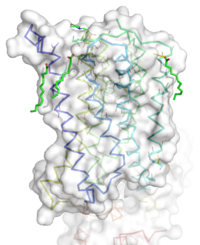Sandbox Reserved 1160
From Proteopedia
(Difference between revisions)
| Line 11: | Line 11: | ||
=== Extracellular Domain === | === Extracellular Domain === | ||
=== Binding Pocket === | === Binding Pocket === | ||
| - | The binding pocket represents an interesting source of regulatory control of receptor activity. The binding pocket is only accessible by a relatively narrow (7 angstrom) <scene name='72/721531/Protien_sur/4'>entrance</scene>. This small entrance severely restricts the | + | The binding pocket represents an interesting source of regulatory control of receptor activity. The binding pocket is only accessible by a relatively narrow (7 angstrom) <scene name='72/721531/Protien_sur/4'>entrance</scene>. This small entrance severely restricts the access of both positive and negative allosteric regulators. This structural feature will severely limit the size of possible regulators. |
Important Amino Acids: | Important Amino Acids: | ||
*<scene name='72/721531/Protien_bindtop/4'>Asparagine</scene> 747forms a hydrogen bond network with main chain carbonyl of 652 and the carbamate portion of mavoglurant. | *<scene name='72/721531/Protien_bindtop/4'>Asparagine</scene> 747forms a hydrogen bond network with main chain carbonyl of 652 and the carbamate portion of mavoglurant. | ||
| Line 18: | Line 18: | ||
*A <scene name='72/721531/Protien_bindbottom/1'>water molecular</scene> inside of the binding pocket helps stabilize the inactive state. | *A <scene name='72/721531/Protien_bindbottom/1'>water molecular</scene> inside of the binding pocket helps stabilize the inactive state. | ||
| - | Once bound to Mavoglurant, | + | Once bound to Mavoglurant, transmembrane helix 7 undergoes a conformational change. The shifting of TM7 will lead to a more global conformational change, which we leave the receptor incapable of signaling. |
=== Ionic Locks === | === Ionic Locks === | ||
| - | Another important structural feature of the protein is the series of <scene name='72/721531/Ionic_lock/2'>ionic locks</scene> on the intracellular side of the protein. | + | Another important structural feature of the protein is the series of <scene name='72/721531/Ionic_lock/2'>ionic locks</scene> on the intracellular side of the protein. Interaction between amino acids will form a salt bridge which will stabilize the inactive conformation. The primary ionic lock forms between Glu770, Lys665, and Ser613. A secondary ionic lock occurs between Ser614 and Arg668. The purpose of these ionic locks are analogous to the ionic interactions that stabilize the T state in hemoglobin. In the case of the TMD, when the NAM mavoglurant is bound the ionic lock is formed. This stabilizes the inactive state, where the intracellular loops are stabilized. This will effectively block |
== Function and Pathway == | == Function and Pathway == | ||
Revision as of 23:47, 29 March 2016
Human metabotropic glutamate receptor 5 transmembrane domain
| |||||||||||
References
- ↑ 1.0 1.1 Dore AS, Okrasa K, Patel JC, Serrano-Vega M, Bennett K, Cooke RM, Errey JC, Jazayeri A, Khan S, Tehan B, Weir M, Wiggin GR, Marshall FH. Structure of class C GPCR metabotropic glutamate receptor 5 transmembrane domain. Nature. 2014 Jul 31;511(7511):557-62. doi: 10.1038/nature13396. Epub 2014 Jul 6. PMID:25042998 doi:http://dx.doi.org/10.1038/nature13396
- ↑ 2.0 2.1 2.2 2.3 Wu H, Wang C, Gregory KJ, Han GW, Cho HP, Xia Y, Niswender CM, Katritch V, Meiler J, Cherezov V, Conn PJ, Stevens RC. Structure of a class C GPCR metabotropic glutamate receptor 1 bound to an allosteric modulator. Science. 2014 Apr 4;344(6179):58-64. doi: 10.1126/science.1249489. Epub 2014 Mar , 6. PMID:24603153 doi:http://dx.doi.org/10.1126/science.1249489

